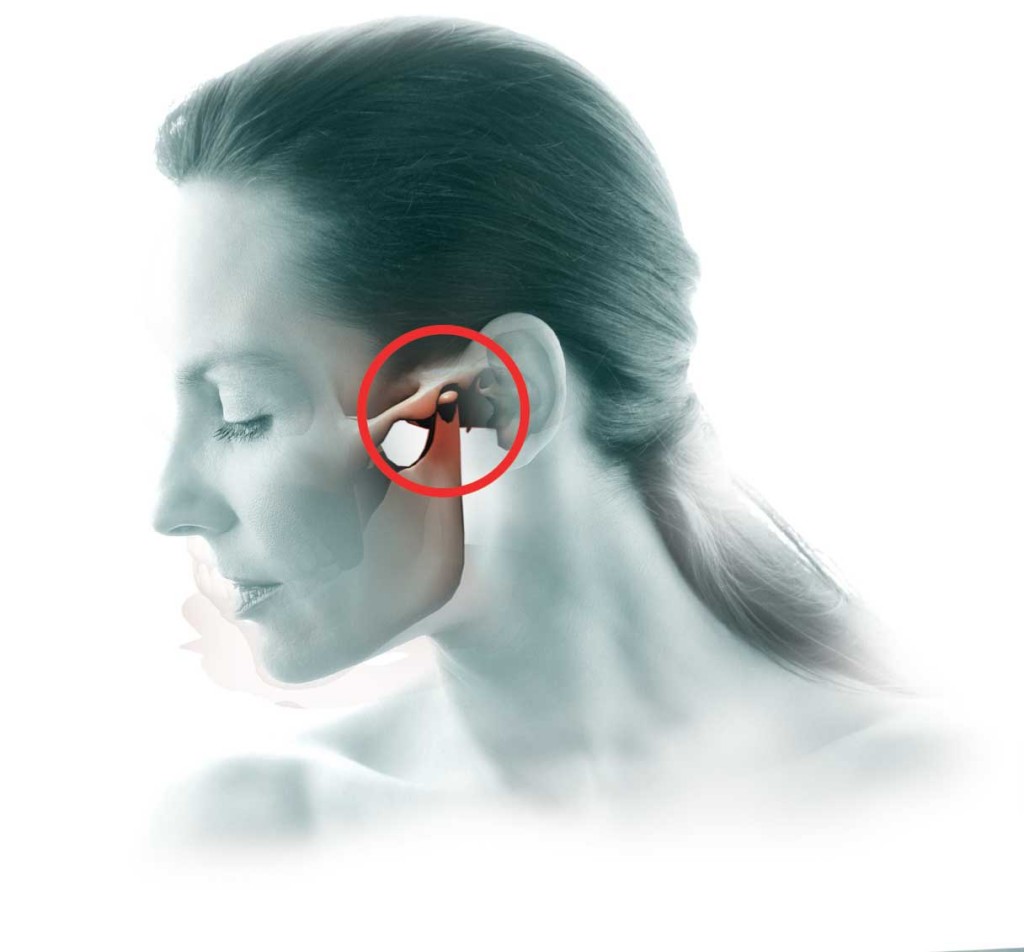The Temporomandibular Joint
If you place your fingers in front of either ear and open your jaw, you’ll feel changing shapes beneath your fingers. You are feeling the joint where the temporal bone of your skull attaches to your mandible (jaw)-the joint that is called the temporomandibular joint or TMJ. This fascinating joint connects your jaw to your head. Ligaments, cartilage, fascia, an articular disc, muscles, nerves and blood vessels run in, around and through the TMJ.
Symptoms of TMJ Syndrome
TMJ dysfunction or syndrome occurs when the joint is misaligned or malfunctioning in some way that subjects it to excess pressure. Among the most common symptoms of TMJ dysfunction are the inability to open the mouth wide and a clicking or popping sound when the mouth opens or closes. In some cases, the jaw can even temporarily lock up.
Other TMJ symptoms can be severe headaches; loss of hearing; tinnitus (ringing in the ears); the sensation of an object in the throat; facial swelling; shoulder, cheek or jaw joint pain; neck ache; tic douloureux (facial nerve pain); pain in or under the ear, the eye or upon swallowing; tooth pain; migraine: nausea; blurred vision and dizziness.
Some researchers have even linked TMJ dysfunction to throat infections, sinus congestion, ear infections and asthma. Others have linked the syndrome to heart, stomach, intestinal, respiratory and emotional disorders.
Who Gets TMJ?
According to John D. Laughlin 111, president of the Holistic Dental Association:
Up to seventy-eight percent of the general public (over 175 million) have some amount of TMJ dysfunction. This condition can begin during the birth process. One of the primary causes can be poor nutrition. TMJ affects more women than men, with high stress “superwomen” being very prone to it.
Causes of TMJ
TMJ may be caused by trauma: a child may fall on its sacrum and in time, through the adaptive body mechanisms, the pelvic imbalance can affect the TMJ, head and neck. According to Dr. Gerald Smith, a specialist in the field of structural dentistry, dental work, especially improperly fitting braces or orthodontia is the cause of many TMJ problems:
Chronic headaches, scalp tenderness, pains behind the eyes, muffled ear sounds, ringing, hissing or other ear distortions, balance problems, nausea, facial tightness, cervical or lower back pain or restriction of neck motion should all be thoroughly investigated for possible implication in cranial distortions, especially if they appear within days after braces are placed. These same symptoms may surface within a period of six months to several years. Sometimes the head pains caused by ill-fitting dental work can be quite intense. TMJ may also be caused by trauma of many kinds, not only those directly affecting the head and jaw and not only those of recent origin.
The Chiropractic Approach
Spinal and TMJ problems are often found together. Chiropractic care, especially in the area of the upper cervical spine and skull, often relieves pressure on the spine and the cranial bones. Often a chiropractic spinal adjustment can greatly benefit someone suffering from what had been thought to be only a TMJ problem. Conversely, an unhealthy skull/jaw alignment can put great stress upon the spinal column. There are documented cases of dental problems that, once corrected, have helped chiropractic patients to better hold their spinal adjustments.
In one study, 30 chronic TMJ sufferers were randomised into 3 groups (two had chiropractic and one was a control). The groups receiving chiropractic care had the most significant relief from pain. In another study, sixty patients with chronic cervical pain were divided into chiropractic and control groups. There was a dramatic improvement in TMJ pain in the chiropractic group compared to the control group. Eleven patients with chronic TMJ revealed a shift from high-intensity to low-intensity pain between the beginning and end of care (63.6% to 18.2%). A significant change of mouth opening range was also observed.
An individual case involved a 41-year-old woman with bilateral TMJ pain, ear pain, tinnitus, vertigo, decreased hearing and a sensation of pressure or fullness in both ears. She also had a 22 year history of migraine headaches. Prescribed antibiotics caused gastric upset and vomiting. MDs told her to apply local heat, reduce talking and eat soft foods. Her symptoms worsened. Chiropractic care to the atlas vertebrae resulted in complete relief of TMJ symptoms after 9 visits and headache relief. At a one year follow-up she reported no TMJ symptoms and no headaches for the prior 9 months.
In Conclusion
Certain chiropractic and body alignment techniques have been developed that analyze skull/jaw/spinal structural relationships. These techniques have benefited patients suffering from the hidden distortions that sometimes arise within us.
All TMJ sufferers should have a chiropractic checkup, and anyone who has been to the dentist should follow up that visit with a quick stop at their chiropractor.



